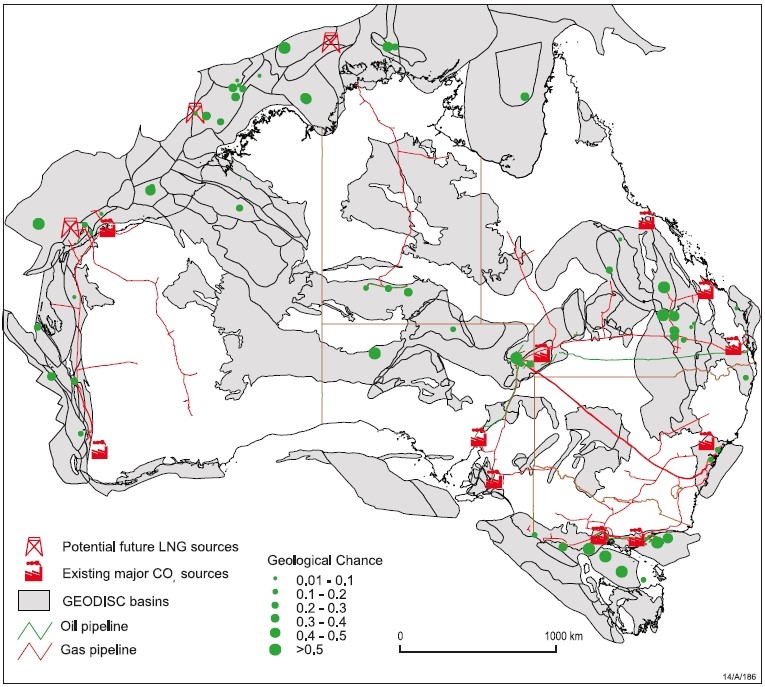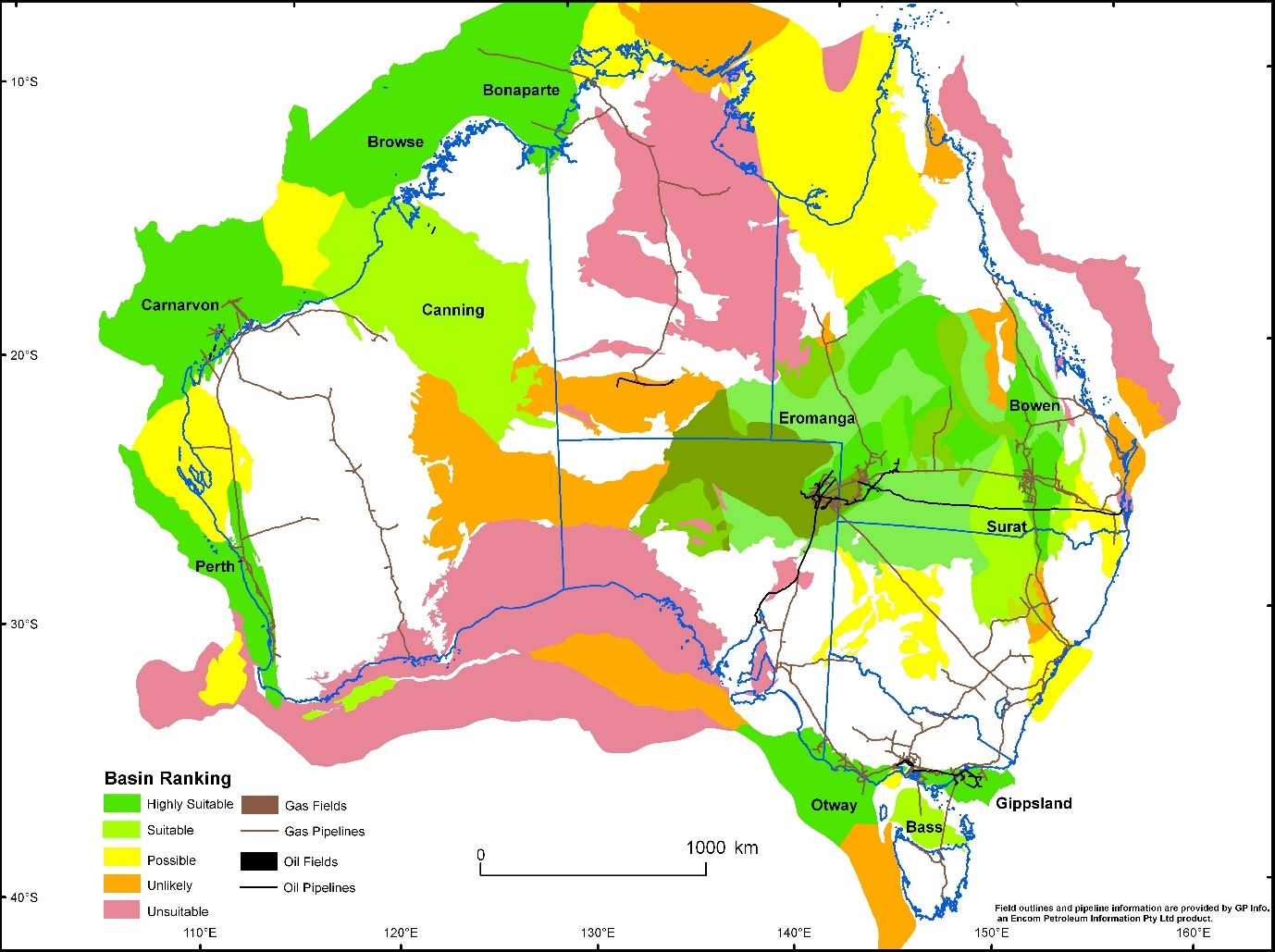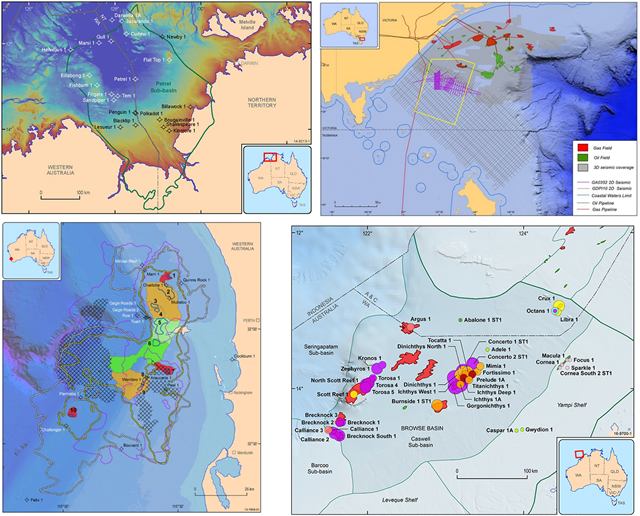Geological Storage Studies
Page last updated:15 December 2023
One of our key roles in CCS over the past 20 or so years has been to identify and assess Australia’s potential and capacity to store carbon dioxide in our sedimentary basins. We have focused, for the most part, on national and basin-scale studies.
APCRC/GEODISC, 1999–2003
GEODISC was a national CO2 storage and infrastructure assessment project completed by Geoscience Australia in 2002 for the Australian Petroleum Cooperative Research Centre (APCRC, 1999–2003). Following a screening study of all of Australia’s sedimentary basins, the regional analysis program examined, in detail, the geological characteristics of nearly 90 sites and 15 regions and their suitability for geological storage, followed by risk and economic analyses and source-sink matching. Spatial data relating to the assessed sites can be accessed through our online data portal and the outcomes of the study are documented in detail in various publications from 2000–2004.
Sites examined for CO2 storage potential under the GEODSIC program and their geological prospectivity (geological chance) for CO2 storage (Bradshaw et al., 2002, figure 4).
CO2CRC basin assessments, 2003–2010
The Cooperative Research Centre for Greenhouse Gas Control Technologies (CO2CRC) was established in 2003 following the conclusion of the APCRC as a collaborative research and demonstration hub for CCS. As a partner in the CO2CRC, Geoscience Australia was involved in a range of collaborative research and development efforts related to CO2 geological storage, greenhouse gas monitoring and verification, and the development of a CO2 injection demonstration site in Australia (the CO2CRC Otway International Test Centre). Geological storage assessments were completed for, among others, the Otway, Galilee, Bowen, Gippsland, Sydney, Darling, Perth and Collie Basins (see publications). Other research included completion of the fault seal integrity project.
Following its conclusion under the cooperative research centre, CO2CRC formed a not-for-profit research organisation. Geoscience Australia as a partner, continues to work with CO2CRC, members and stakeholders on geological storage and greenhouse gas monitoring related projects. For more information, see our publications and the CO2CRC website.
National carbon mapping and infrastructure plan (NCMIP), 2009
A national and basin-scale assessment of Australia’s potential and capacity to transport and store CO2 was completed in 2009 for the Carbon Storage Taskforce (under the National Low Emissions Coal Initiative - NLECI). The high-level assessment took into consideration geological characteristics and other factors in order to determine the potential, capacity and ranking of sedimentary basins for CO2 geological storage. As part of this project, the CO2 Pipeline Route Planning Tool was implemented to model optimal pathways between CO2 emissions sources and potential CO2 storage sites. Read the full report, and access the basin ranking spatial data and the pipeline tool through our online data portal.
National CO2 infrastructure plan (NCIP), 2012–2016
This program was established under the National Low Emission Coal Initiative to accelerate identification and development of CO2 storage sites close to major emission sources (NLECI). Under the NCIP program, four regions were examined in detail to determine their potential for CO2 storage, including acquisition of new geological data.
For more details on each of these projects, as well as related publications and data packages, please see:
- Petrel Sub-basin (Bonaparte Basin) CO2 Storage Assessment
- Gippsland Basin CO2 Storage Assessment
- Vlaming Sub-basin (Perth Basin) CO2 Storage Assessment
- Browse Basin CO2 Storage Project
- Onshore Carbon Storage Project (NSW, WA)
Offshore regions assessed for CO2 storage potential under the NCIP program. Clockwise from top left: Bonaparte Basin; Gippsland Basin; Browse Basin; Vlaming Sub-basin.
Significant geological storage studies
State Government agencies, CSIRO, CO2CRC, universities and industry have completed many studies and R&D programs on the various aspects of CCS. These include:
- Queensland Government’s Queensland CO2 Storage Geological Atlas 2010
- Western Australia’s CCS program and Carbon Dioxide Storage Atlas (2014)
- NSW Government’s New South Wales precompetitive CO2 Storage Assessment Project
- Victorian Government’s ongoing CarbonNet project and related CCS work
- CO2CRC geological storage research projects
CCS projects in Australia
There are a range of operational CCS projects world-wide including at pilot, demonstration, and commercial-scale that include capture, storage or the entire CCS chain. The Global CCS Institute (GCCSI) keeps an up to date record of CCS facilities and projects.
In Australia, there are currently several significant CCS projects in various stages of operation and development.
- The commercial Gorgon LNG Project in Western Australia, operated by Chevron Australia, where CO2 is separated from natural gas produced from the Gorgon and Jansz-Io fields and reinjected underground into a saline reservoir, the Dupuy Formation, beneath Barrow Island. CO2 injection commenced in August 2019.
- The CarbonNet Project, Victoria, seeks to develop a CO2 collection hub with geological storage in the offshore part of the Gippsland Basin. This project was supported by the Australian Government’s CCS Flagships program.
- The Moomba CCS project in South Australia, a joint effort by Santos and Beach Energy, aims to store 1.7 million tonnes of CO2 each year, with the potential to eventually store 20 million tonnes of CO2 per year.
- The South-West Hub Project, Western Australia, is investigating CO2 storage in the Perth Basin. This project was supported by the Australian Government’s CCS Flagships program.
- CTSCo’s Surat Basin CCS Project is aiming to demonstrate the technical viability of the CCS chain in the Surat Basin, funded by Low Emission Technology Australia and the Australian Government.
- CO2CRC Otway International Test Centre. CO2CRC continues to operate Australia’s key CCS research and demonstration injection and monitoring facility near Port Campbell, in the Otway Basin, Victoria, some 15 years since its inception. The Otway geological storage and monitoring demonstration project is supported by the Australian Government’s CCS Flagships program.
Completed pre-feasibility studies
- The ZeroGen Project, Bowen Basin, Queensland.
- The Wandoan Power Project, Queensland.



